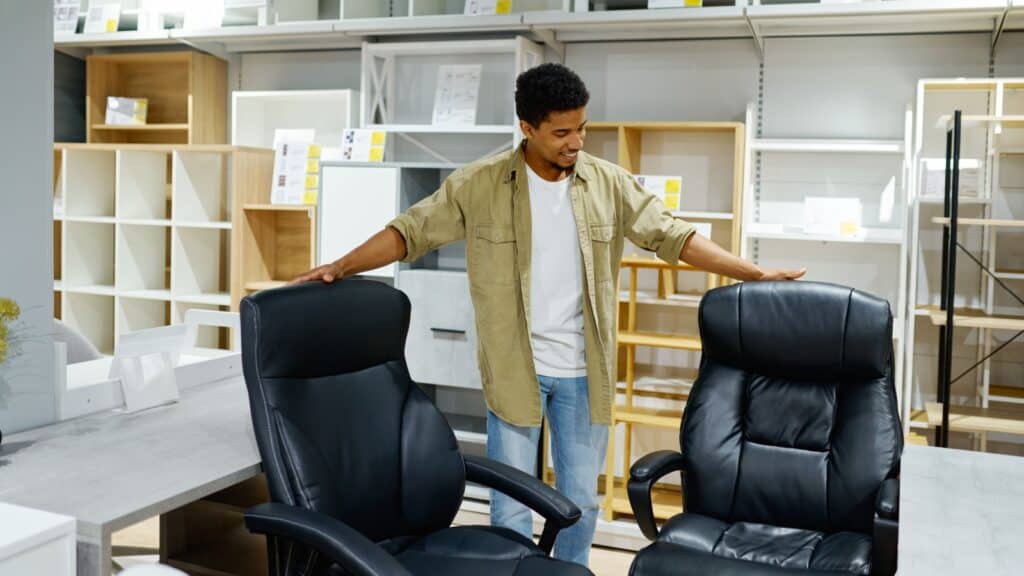Find the Right Fit: How to Choose the Best Ergonomic Chair for Your Body Type!
Many of us spend hours seated at our desks, whether for work, gaming, or leisure. The importance of a good ergonomic chair cannot be overstated—it’s an investment in your health and productivity. However, with so many options on the market, finding the right chair can feel overwhelming. This article will guide you through the process of choosing the right ergonomic chair tailored to your height, body type, and specific needs.
How Do You Know If You Need A New Chair?

If you suffer from lower back pain, upper back pain, neck pain, hand issues, sciatica, numbness in legs (to name just some potential issues), and especially if you spend many hours every day in a chair, there is a good chance your chair is not helping you in these areas, and in fact might be creating or adding to these issues.
What Makes a Chair “Ergonomic”?

Before diving into the specifics of selecting a chair, it’s essential to understand what makes a chair ergonomic. An ergonomic chair is designed to support the natural posture of the human body, reducing strain on muscles, joints, and the spine. Key features of an ergonomic chair include:
- Adjustable Seat Height: Allows the chair to be adjusted to the user’s height.
- Lumbar Support: Supports the natural curve of the lower back.
- Seat Depth Adjustment: Ensures your thighs are properly supported.
More Ergonomic Features

Look for these features, as well:
- Armrests: Adjustable armrests support your arms comfortably while typing or working.
- Swivel and Mobility: Enables easy movement around your workspace.
- Recline Function: Allows the backrest to tilt for additional comfort.
Step 1: Measure Your Height and Identify Your Needs

Your height plays a critical role in determining the right ergonomic chair for you. A chair that is too high or too low can cause discomfort and lead to long-term health issues. Here’s how to approach it:
Seat Height

A chair’s seat height should allow your feet to rest flat on the floor with your knees at a 90-degree angle. For most people, a seat height range of 16 to 21 inches off the floor works well. However, if you are taller or shorter than average, you may need a chair that offers more height adjustment.
- For shorter individuals (under 5’5″): Look for chairs with a lower minimum seat height (around 14-16 inches) to ensure your feet can touch the floor comfortably. Consider using a footrest if needed.
- For taller individuals (over 6’2″): A chair with a higher maximum seat height (22 inches or more) may be necessary to maintain proper posture.
Seat Depth

Proper seat depth is essential for adequate thigh support. You should be able to sit with your back against the backrest while having 2 to 4 inches between the edge of the seat and the back of your knees. If the seat is too deep, it can cut off circulation to your legs; if it’s too shallow, you may not get enough support. Many ergonomic chairs offer adjustable seat depth, which is particularly useful for taller or shorter individuals.
Step 2: Evaluate Lumbar Support

The lumbar region of your spine has a natural inward curve that needs to be supported when sitting. Without proper lumbar support, you may experience back pain and fatigue. When choosing an ergonomic chair:
- Adjustable Lumbar Support: Look for a chair with adjustable lumbar support that can be moved up and down or in and out to fit the curve of your lower back. This is especially important if you share the chair with others of different heights.
- Built-in Lumbar Cushioning: Some chairs come with built-in lumbar cushions that conform to the shape of your back. These can be beneficial, but ensure they provide firm support without being too soft or too hard.
Step 3: Consider Armrests and Their Adjustability

Armrests are more than just a place to rest your arms—they can help reduce strain on your shoulders and neck. Here’s what to look for:
- Height Adjustable Armrests: Your armrests should be adjustable in height so that your arms can rest at a 90-degree angle, with your elbows close to your body. If the armrests are too high or too low, they can cause discomfort and lead to poor posture.
- Width Adjustable Armrests: Some chairs offer adjustable width armrests, which can be particularly helpful for larger individuals or those who prefer a wider space between their arms.
- Pivoting Armrests: Pivoting or rotating armrests allow you to adjust the angle to suit different activities, such as typing or reading.
Step 4: Analyze the Backrest and Recline Function

A good ergonomic chair should support your back throughout its entire length. When considering the backrest:
- Height Adjustable Backrest: If possible, choose a chair with a height-adjustable backrest to ensure support for your entire back, including your shoulders.
- Recline and Tilt Mechanism: The ability to recline and lock the chair at various angles is crucial for relieving pressure on your spine throughout the day. A chair that reclines slightly (100 to 110 degrees) can reduce strain on your lower back. For tasks that require focus, an upright position is ideal, while a more relaxed recline can be useful during breaks.
Step 5: Material and Cushioning

The material and cushioning of a chair affect both comfort and durability:
- Breathable Fabric: Look for a chair with breathable material, such as mesh, which allows air circulation and keeps you cool during long hours of sitting. Leather or faux leather can also be comfortable but may not be as breathable.
- Firm but Comfortable Cushioning: The seat cushion should be firm enough to support your weight without flattening over time, but comfortable enough to sit on for extended periods. Memory foam cushions are popular for this reason, as they conform to your body while providing support.
Step 6: Test the Chair if Possible

If you have the opportunity to test a chair before purchasing, take it. Everyone’s body is different, and what feels comfortable for one person may not work for another. When testing:
- Adjust the Chair Fully: Make sure you can easily adjust the chair’s height, armrests, backrest, and lumbar support.
- Sit for an Extended Period: Don’t just sit in the chair for a minute—try to spend at least 15-20 minutes in it to get a feel for how it supports your body over time.
- Check for Stability: Ensure the chair feels stable and doesn’t wobble or tip easily when you move around.
Let’s Go Chair Shopping!

Choosing the right ergonomic chair is a critical decision that can have a lasting impact on your comfort and health. By considering your height, body type, and specific needs, and by paying attention to key features such as seat height, lumbar support, armrests, and material, you can find a chair that will keep you comfortable and productive throughout the day. Remember, an ergonomic chair is not just a piece of furniture—it’s an investment in your well-being.
Ditch Your Chair Now! These Sitting Alternatives Could Save Your Health

Sitting for prolonged periods has become the norm, whether at work, during commutes, or at home. However, extended sitting has been linked to various health issues, including back pain, poor posture, and even increased risks of chronic diseases. As awareness of these risks grows, many people are exploring alternatives to traditional chairs that promote better posture, increased movement, and overall well-being. Here are some of the most popular sitting alternatives, including standing desks, walking pads, exercise balls, kneeling chairs, and saddle stools, to help you find the best option for your needs.
READ: Ditch Your Chair Now! These Sitting Alternatives Could Save Your Health
Science Tells Us What To Expect As We Age: Strategies For Thriving In Later Life

How does aging affect our bodies and minds, and how can we adapt to those differences? These are questions that pertain to us all. Aging gradually alters people over decades, a long period shaped by individuals’ economic and social circumstances, their behaviors, their neighborhoods, and other factors. Also, while people experience common physiological issues in later life, they don’t follow a well-charted, developmentally predetermined path. Let’s take a look at what science has told us to expect. Read: Science Tells Us What To Expect As We Age: Strategies For Thriving In Later Life
3 Simple Somatic Movements You Can Do To Calm Your Nervous System

Daily life can be unnerving. And it’s easy to go from calm to anxious or nervous in a flash. What’s harder is to go from anxious or nervous to calm.These simple movements that I am going to share here have been found to successfully move an individual from a state of anxious nervousness to a state of calm. Read: 3 Simple Somatic Movements You Can Do To Calm Your Nervous System
Join Us

Join us on this empowering journey as we explore, celebrate, and elevate “her story.” The Queen Zone is not just a platform; it’s a community where women from all walks of life can come together, share their experiences, and inspire one another. Welcome to a space where the female experience takes center stage. Sign up for our newsletter so you don’t miss a thing, Queen!







